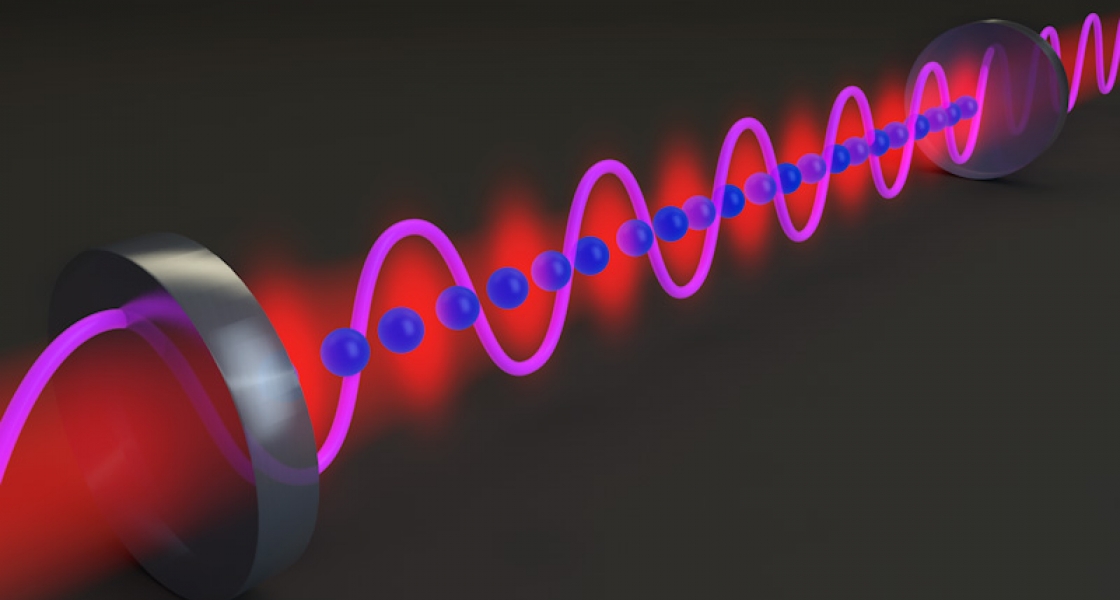Move over, single-atom laser cooling! The Holland theory group has just come up with a stunning idea for a new kind of laser cooling for use with ensembles of atoms that all “talk” to each other. In other words, the theory looks at laser cooling not from the perspective of cooling a single atom, but rather from the perspective of many atoms working together to rapidly cool themselves to a miniscule fraction of a degree above absolute zero. And, this new theory (which hasn’t been tried out yet in the lab) would not only cool atom ensembles to record-breaking low temperatures, but also cool them down even faster than ever before!
The proposed cooling method is related to the operation of a superradiant laser. In a superradiant laser, the collective effects of all the atoms in the laser talking to each other determines the narrow linewidth, or frequency stability, of the laser light. With cooling, the collective effects of all the atoms talking to each other means it may be feasible to get a cloud of atoms even colder under superradiant conditions than physicists thought possible.
The theorists responsible for this tantalizing new idea include graduate student Minghui Xu, retired Fellow Jinx Cooper, and Fellow Murray Holland as well as colleagues from the Universität des Saarlandes (Germany).
“This is actually the best of both worlds,” explained Fellow Murray Holland. “You get the atoms really cold, and because of the superradiant effect, the plunging temperatures increase the number of photons being emitted by atoms, which makes the atoms slow down more rapidly and the cooling happen faster.”
The idea for superradiant laser cooling is so new, Holland and his group don’t yet know its limits. Finding those limits may be a hard problem to solve because of the sheer difficulty of calculating the behavior of systems with many particles within the framework of quantum theories.
“We know that it gets very cold,” Holland said. “It gets down to the recoil limit, which is the limit for most laser-cooling schemes.” He noted that, in theory, it only takes about 20 atoms under superradiant conditions to cool down to just above absolute zero. He’s eager to see what would happen in an experiment using 10,000 to 100,000 atoms.
Holland may soon get his wish, says experimentalist James Thompson.
“The Holland group’s idea is really exciting because it moves laser cooling into a whole new regime in which having many atoms present is fundamental to the cooling,” said Thompson. “This idea is very different from previous laser-cooling techniques that have been used to cool single atoms, molecules, and micromechanical objects.
“My group is anxious to see if we can build an experiment to see this collective cooling in action.”––Julie Phillips



 The Physics Frontiers Centers (PFC) program supports university-based centers and institutes where the collective efforts of a larger group of individuals can enable transformational advances in the most promising research areas. The program is designed to foster major breakthroughs at the intellectual frontiers of physics by providing needed resources such as combinations of talents, skills, disciplines, and/or specialized infrastructure, not usually available to individual investigators or small groups, in an environment in which the collective efforts of the larger group can be shown to be seminal to promoting significant progress in the science and the education of students. PFCs also include creative, substantive activities aimed at enhancing education, broadening participation of traditionally underrepresented groups, and outreach to the scientific community and general public.
The Physics Frontiers Centers (PFC) program supports university-based centers and institutes where the collective efforts of a larger group of individuals can enable transformational advances in the most promising research areas. The program is designed to foster major breakthroughs at the intellectual frontiers of physics by providing needed resources such as combinations of talents, skills, disciplines, and/or specialized infrastructure, not usually available to individual investigators or small groups, in an environment in which the collective efforts of the larger group can be shown to be seminal to promoting significant progress in the science and the education of students. PFCs also include creative, substantive activities aimed at enhancing education, broadening participation of traditionally underrepresented groups, and outreach to the scientific community and general public.